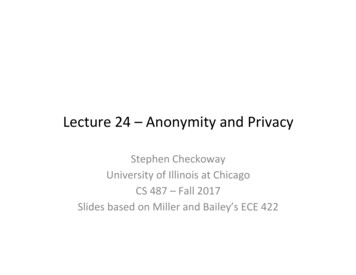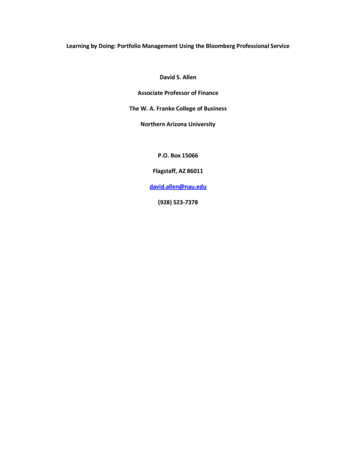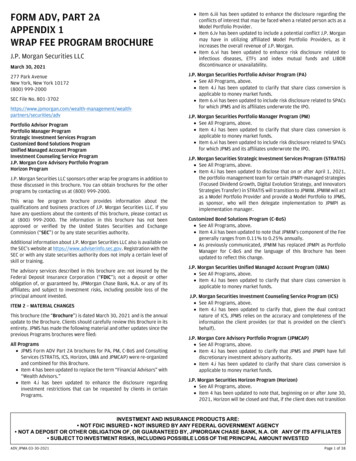
Transcription
For Alice
CONTENTSTitle PageCopyright NoticeDedicationPrologueA General Theory of WalkabilityI: WHY WALKABILITY?Walking, the Urban AdvantageWhy Johnny Can’t WalkThe Wrong Color GreenII: THE TEN STEPS OF WALKABILITYThe Useful WalkStep 1: Put Cars in Their PlaceStep 2: Mix the UsesStep 3: Get the Parking RightStep 4: Let Transit WorkThe Safe WalkStep 5: Protect the PedestrianStep 6: Welcome BikesThe Comfortable WalkStep 7: Shape the SpacesStep 8: Plant TreesThe Interesting WalkStep 9: Make Friendly and Unique Faces
Step 10: Pick Your WinnersAcknowledgmentsNotesWorks CitedGeographic IndexGeneral IndexAlso by Jeff SpeckPraise for Walkable CityCopyright
PROLOGUEThis is not the next great book on American cities. That book is not needed. Anintellectual revolution is no longer necessary. What characterizes the discussion oncities these days is not a wrongheadedness or a lack of awareness about what needs tobe done, but rather a complete disconnect between that awareness and the actions ofthose responsible for the physical form of our communities.We’ve known for three decades how to make livable cities—after forgetting forfour—yet we’ve somehow not been able to pull it off. Jane Jacobs, who wrote in1960, won over the planners by 1980. But the planners have yet to win over the city.Certain large cities, yes. If you make your home in New York, Boston, Chicago,San Francisco, Portland, or in a handful of other special places, you can have someconfidence that things are on the right track. But these locations are the exceptions. Inthe small and midsized cities where most Americans spend their lives, the dailydecisions of local officials are still, more often than not, making their lives worse.This is not bad planning but the absence of planning, or rather, decision-makingdisconnected from planning. The planners were so wrong for so many years that nowthat they are mostly right, they are mostly ignored.But this book is not about the planning profession, nor is it an argument for moreplanning per se. Instead, it is an attempt to simply delineate what is wrong with mostAmerican cities and how to fix it. This book is not about why cities work or howcities work, but about what works in cities. And what works best in the best cities iswalkability.Walkability is both an end and a means, as well as a measure. While the physicaland social rewards of walking are many, walkability is perhaps most useful as itcontributes to urban vitality and most meaningful as an indicator of that vitality. Afterseveral decades spent redesigning pieces of cities, trying to make them more livableand more successful, I have watched my focus narrow to this topic as the one issuethat seems to both influence and embody most of the others. Get walkability right andso much of the rest will follow.This discussion is necessary because, since midcentury, whether intentionally or byaccident, most American cities have effectively become no-walking zones. In theabsence of any larger vision or mandate, city engineers—worshiping the twin gods ofSmooth Traffic and Ample Parking—have turned our downtowns into places that areeasy to get to but not worth arriving at. Outdated zoning and building codes, often
imported from the suburbs, have matched the uninviting streetscape with equallyantisocial private buildings, completing a public realm that is unsafe, uncomfortable,and just plain boring. As growing numbers of Americans opt for more urban lifestyles,they are often met with city centers that don’t welcome their return. As a result, asmall number of forward-thinking cities are gobbling up the lion’s share of post-teensuburbanites and empty nesters with the wherewithal to live wherever they want,while most midsized American cities go hungry.How can Providence, Grand Rapids, and Tacoma compete with Boston, Chicago,and Portland? Or, more realistically, how can these typical cities provide theircitizens a quality of life that makes them want to stay? While there are many answersto that question, perhaps none has been so thoroughly neglected as design, and how acomprehensive collection of simple design fixes can reverse decades ofcounterproductive policies and practices and usher in a new era of street life inAmerica.These fixes simply give pedestrians a fighting chance, while also embracing bikes,enhancing transit, and making downtown living attractive to a broader range of people.Most are not expensive—some require little more than yellow paint. Each oneindividually makes a difference; collectively, they can transform a city and the lives ofits residents.Even New York and San Francisco still get some things wrong, but they willcontinue to poach the country’s best and brightest unless our other, more normal citiescan learn from their successes while avoiding their mistakes. We planners arecounting on these typical places, because America will be finally ushered into “theurban century” not by its few exceptions, but by a collective movement among itseveryday cities to do once again what cities do best, which is to bring people together—on foot.
A GENERAL THEORY OFWALKABILITYAs a city planner, I make plans for new places and I make plans for making old placesbetter. Since the late eighties, I have worked on about seventy-five plans for cities,towns, and villages, new and old. About a third of these have been built or are wellunder way, which sounds pretty bad, but is actually a decent batting average in thisgame. This means that I have had my fair share of pleasant surprises as well as manyopportunities to learn from my mistakes.In the middle of this work, I took four years off to lead the design division at theNational Endowment for the Arts. In this job, I helped run a program called theMayors’ Institute on City Design, which puts city leaders together with designers forintensive planning sessions. Every two months, somewhere in the United States, wewould gather eight mayors and eight designers, lock ourselves in a room for two days,and try to solve each mayor’s most pressing city-planning challenge. As might beimagined, working side by side with a couple hundred mayors, one mayor at a time,proved a greater design education than anything I have done before or since.I specialize in downtowns, and when I am hired to make a downtown plan, I like tomove there with my family, preferably for at least a month. There are many reasons tomove to a city while you plan it. First, it’s more efficient in terms of travel and settingup meetings, something that can become very expensive. Second, it allows you to trulyget to know a place, to memorize every building, street, and block. It also gives youthe chance to get familiar with the locals over coffee, dinners in people’s homes,drinks in neighborhood pubs, and during chance encounters on the street. Thesenonmeeting meetings are when most of the real intelligence gets collected.These are all great reasons. But the main reason to spend time in a city is to live thelife of a citizen. Shuttling between a hotel and a meeting facility is not what citizensdo. They take their kids to school, drop by the dry cleaners, make their way to work,step out for lunch, hit the gym or pick up some groceries, get themselves home, andconsider an evening stroll or an after-dinner beer. Friends from out of town drop in onthe weekend and get taken out for a night on the main square. These are among themany normal things that nonplanners do, and I try to do them, too.A couple of years ago, while I was working on a plan for Lowell, Massachusetts,some old high-school friends joined us for dinner on Merrimack Street, the heart of alovely nineteenth-century downtown. Our group consisted of four adults, one toddler
in a stroller, and my wife’s very pregnant belly. Across the street from our restaurant,we waited for the light to change, lost in conversation. Maybe a minute passed beforewe saw the pushbutton signal request. So we pushed it. The conversation advanced foranother minute or so. Finally, we gave up and jaywalked. About the same time, a carcareened around the corner at perhaps forty-five miles per hour, on a street that hadbeen widened to ease traffic.The resulting near-miss fortunately left no scars, but it will not be forgotten.Stroller jaywalking is a surefire way to feel like a bad parent, especially when it goesawry. The only consolation this time was that I was in a position to do somethingabout it.As I write these words, I am again on the road with my family, this time in Rome.Now the new baby is in a sling, and the toddler alternates between a stroller and hisown two feet, depending on the terrain and his frame of mind. It is interesting tocompare our experience in Rome with the one in Lowell, or, more to the point, theexperience of walking in most American cities.Rome, at first glance, seems horribly inhospitable to pedestrians. So many thingsare wrong. Half the streets are missing sidewalks, most intersections lack crosswalks,pavements are uneven and rutted, handicap ramps are largely absent. Hills are steepand frequent (I hear there are seven). And need I mention the drivers?Yet here we are among so many other pedestrians—tourists and locals alike—making our way around Trastevere on our toes, yes, but enjoying every minute of it.This anarchic obstacle course is somehow a magnet for walkers, recently selected byreaders of Lonely Planet travel guides as one of the world’s “Top Ten WalkingCities.” Romans drive a fraction of the miles that Americans do. A friend of ours whocame here to work in the U.S. embassy bought a car when he arrived, out of habit.Now it sits in his courtyard, a target for pigeons.This tumultuous urban landscape, which fails to meet any conventional Americanmeasure of “pedestrian friendliness,” is a walker’s paradise. So what’s going onhere? Certainly, in competing for foot traffic, Anatole Broyard’s “poem pressed intoservice as a city” began with certain advantages. The Lonely Planet ranking is likelymore a function of spectacle than pedestrian comfort. But the same monuments,arranged in a more modern American way, would hardly compete. (Think Las Vegas,with its Walk Score of 54 .) The main thing that makes Rome—and the other winners:Venice, Boston, San Francisco, Barcelona, Amsterdam, Prague, Paris, and New York—so walkable is what we planners call “fabric,” the everyday collection of streets,blocks, and buildings that tie the monuments together. Despite its many technical
failures, Rome’s fabric is superb.Yet fabric is one of several key aspects of urban design that are missing from thewalkability discussion in most places. This is because that discussion has largely beenabout creating adequate and attractive pedestrian facilities, rather than walkablecities. There is no shortage of literature on this subject and even a fledgling field of“walkability studies” that focuses on impediments to pedestrian access and safety,mostly in the Toronto suburbs. These efforts are helpful, but inadequate. The samegoes for urban beautification programs, such as the famous “Five B’s” of the eighties—bricks, banners, bandstands, bollards, and berms—that now grace many anabandoned downtown.1Lots of money and muscle have gone into improving sidewalks, crossing signals,streetlights, and trash cans, but how important are these things, ultimately, inconvincing people to walk? If walking was just about creating safe pedestrian zones,then why did more than 150 Main Streets pedestrianized in the sixties and seventiesfail almost immediately?2 Clearly, there is more to walking than just making safe,pretty space for it.The pedestrian is an extremely fragile species, the canary in the coal mine of urbanlivability. Under the right conditions, this creature thrives and multiplies. But creatingthose conditions requires attention to a broad range of criteria, some more easilysatisfied than others. Enumerating and understanding these criteria is a project for alifetime—it has become mine—and is forever a work in progress. It is presumptuousto claim to have figured it out, but since I have spent a lot of time trying, I reckon it isworth communicating what I have learned so far. Since it tries to explain so much, Icall this discussion the General Theory of Walkability.The General Theory of Walkability explains how, to be favored, a walk has tosatisfy four main conditions: it must be useful, safe, comfortable, and interesting. Eachof these qualities is essential and none alone is sufficient. Useful means that mostaspects of daily life are located close at hand and organized in a way that walkingserves them well. Safe means that the street has been designed to give pedestrians afighting chance against being hit by automobiles; they must not only be safe but feelsafe, which is even tougher to satisfy. Comfortable means that buildings andlandscape shape urban streets into “outdoor living rooms,” in contrast to wide-openspaces, which usually fail to attract pedestrians. Interesting means that sidewalks arelined by unique buildings with friendly faces and that signs of humanity abound.These four conditions are mostly a way of thinking about a series of specific rulesthat are further organized into what I call the Ten Steps of Walkability. These will be
explored later. Together, I believe that they add up to a complete prescription formaking our cities more walkable.But first, we must understand that the walkable city is not just a nice, idealisticnotion. Rather, it is a simple, practical-minded solution to a host of complex problemsthat we face as a society, problems that daily undermine our nation’s economiccompetitiveness, public welfare, and environmental sustainability. For that reason,this book is less a design treatise than an essential call to arms. Why we needwalkability so badly is the subject of the next section.
PART IWHY WALKABILITY?
While battle was never declared, many American cities seem to have been madeand remade with a mandate to defeat pedestrians. Fattened roads, emaciatedsidewalks, deleted trees, fry-pit drive-thrus, and ten-acre parking lots havereduced many of our streetscapes to auto zones in which pedestrian life is but atheoretical possibility.The causes of this transformation are sometimes surprising. In Miami, forexample, people wonder why intersections in residential neighborhoods are oftenso fat: two relatively narrow streets will meet in a sweeping expanse of asphaltthat seems to take hours to walk across. The answer is that the firefighters’union once struck a deal that no truck would ever be dispatched without a heftynumber of firemen on it. That’s good for safety and even better for job security,but the fire chief’s response was to purchase only the heftiest trucks. So, formany years, one-story residential neighborhoods in Miami had to be designedaround the lumbering turning radius of a truck built for tall-building fires.1The above anecdote is far from unusual in today’s landscape of disassociatedprofessions and special interests that determine the shape of our communities.The modern world is full of experts who are paid to ignore criteria beyond theirprofessions. The school and parks departments will push for fewer, largerfacilities, since these are easier to maintain—and show off. The public worksdepartment will insist that new neighborhoods be designed principally aroundsnow and trash removal. The department of transportation will build new roads toease traffic generated by the very sprawl that they cause. Each of theseapproaches may seem correct in a vacuum, but is wrong in a city.If they are to function properly, cities need to be planned by generalists, asthey once were. Generalists understand that consolidating parks means thatfewer people can walk to them. Generalists understand that infrastructureorganized in service of big trucks is not always inviting to small people. Andgeneralists, finally, are coming to understand that more lanes usually just lead tomore traffic.Most significantly, generalists—such as planners and, one hopes, mayors—askthe big-picture questions that are so often forgotten among the day-to-dayshuffle of city governance. Questions like: What kind of city will help us thriveeconomically? What kind of city will keep our citizens not just safe, but healthy?What kind of city will be sustainable for generations to come?
These three issues—wealth, health, and sustainability—are, not coincidentally,the three principal arguments for making our cities more walkable.
WALKING, THE URBAN ADVANTAGEThe walking generation; A demographic perfect storm; The walkability dividendMany of my client cities ask me the same question: “How can we attract corporations,citizens, and especially young, entrepreneurial talent?” In Grand Rapids, Michigan,where I am employed by the city’s leading philanthropists, they ask it differently:“How can we keep our children from leaving? How can we keep our grandchildrenfrom leaving?”The obvious answer is that cities need to provide the sort of environment that thesepeople want. Surveys—as if we needed them—show how creative-class citizens,especially millennials, vastly favor communities with street life, the pedestrianculture that can only come from walkability.A lack of street life was one reason why the leadership at Wolverine World Wide,the manufacturers of Merrell and Patagonia Footwear, was having trouble keepingnew creative workers from jumping ship from their suburban West Michiganheadquarters. The problem was not the company, but the impression among newlyarrived spouses that they had no way to break into the social scene even thoughWest Michiganders are known for their openness and hospitality. So what was goingon? It turns out that this social scene could only be accessed by car and thus byinvitation. With no pedestrian culture, there were no opportunities for the chanceencounters that turn into friendships.When it came time to launch a new apparel division, they decided to base it inPortland, Oregon.Since that time, Wolverine has set up a new innovation center along with threeother top West Michigan companies in downtown Grand Rapids. According to BlakeKrueger, Wolverine’s president and CEO, the company needed “an urban hub thatattracts and retains the millennial creative class. You need a vibrant city heartbeat forthese people. Downtown, they’re in a more creative live/work/play environment thanif they are stuck out here in suburbia.” This facility now includes designers andproduct developers across a dozen different brands.For many companies, an urban satellite is not enough. Brand Muscle, formerly ofleafy Beachwood, Ohio, recently relocated all of its 150 employees to downtownCleveland, thanks in part to the desires of a largely twentysomething workforce. Nowstaffer Kristen Babjack brags about her urban lifestyle: “We can leave our apartmentand walk five feet to a restaurant to get something to eat, or to go shopping. We have
all of our arenas and sporting areas and concerts all in one pretty much walkablearea.” Similar stories are making the news in Saint Louis, Buffalo, and even inbeleaguered Detroit.The economic advantage that has already begun to accrue to walkable places canbe attributed to three key factors. First, for certain segments of the population, chiefamong them young “creatives,” urban living is simply more appealing; many wouldn’tbe caught dead anywhere else. Second, massive demographic shifts occurring rightnow mean that these pro-urban segments of the population are becoming dominant,creating a spike in demand that is expected to last for decades. Third, the choice tolive the walkable life generates considerable savings for these households, and muchof these savings are spent locally. I will address each of these factors in turn.THE WALKING GENERATIONWhen I worked for the town planning firm DPZ in Miami in the nineties, everyonedrove to the office, without exception. Taking transit or bicycling made no sense at all,as the buses took forever and the biking was worse than perilous. In more recentvisits, I learned that a significant segment of the young designer workforce now bikesor rides the bus, even though the conditions for either are hardly better.These are the same folks who have put a composting bin in the office kitchen soare they just the exceptions to the rule?It turns out that since the late nineties, the share of automobile miles driven byAmericans in their twenties has dropped from 20.8 percent to just 13.7 percent. And ifone looks at teens, future shifts seem likely to be greater. The number of nineteen-yearolds who have opted out of earning driver’s licenses has almost tripled since the lateseventies, from 8 percent to 23 percent.1 This statistic is particularly meaningful whenone considers how the American landscape has changed since the seventies, whenmost American teens could walk to school, to the store, and to the soccer field, instark contrast to the realities of today’s autocentric sprawl.This trend began well before the recession of 2008 and subsequent fuel spikes, andis seen as cultural, not economic. Market researchers J. D. Power—hardly part of theanticar lobby—report that “online discussions by teens indicate shifts in perceptionsregarding the necessity of and desire to have cars.”2 In “The Great Car Reset,”Richard Florida observes: “Younger people today no longer see the car as anecessary expense or a source of personal freedom. In fact, it is increasingly just theopposite: not owning a car and not owning a house are seen by more and more as apath to greater flexibility, choice, and personal autonomy.” 3 These driving trends are
only a small part of a larger picture that has less to do with cars and more to do withcities, and specifically with how young professionals today view themselves inrelation to the city, especially in comparison to previous generations.Born as the baby boom ended, I grew up watching three television shows almostdaily: Gilligan’s Island , The Brady Bunch, and The Partridge Family. WhileGilligan’s Island may have had little to say about urbanism, the other two wereextremely instructive. They idealized the mid-twentieth-century suburban standard oflow-slung houses on leafy lots, surrounded by more of the same. This was normal andgood. As a would-be architect, I was particularly susceptible to the charms of MikeBrady’s self-built split-level. This is not to say that there were no urban shows on mytelevision set. I saw a good amount of four: Dragnet, Mannix, The Streets of SanFrancisco, and Hawaii 5-0—all focused on one subject: crime. Now, contrast my experience growing up in the seventies with that of a childgrowing up in or around the nineties, watching Seinfeld, Friends, and, eventually, Sexand the City. In these shows, the big city (in all cases New York) was lovinglyportrayed as a largely benevolent and always interesting force, often a character andcoconspirator in its own right. The most urban of American cities was the new normal,and certainly good.The first thing that I take away from this comparison is that I watched far too muchtelevision as a child. But the real point here is that today’s young professionals grewup in a mass culture—of which TV was only one part—that has predisposed them tolook favorably upon cities; indeed, to aspire to live in them. I grew up in the suburbswatching shows about the suburbs. They grew up in the suburbs watching shows aboutthe city. My complacency has been replaced by their longing.This group, the millennials, represent the biggest population bubble in fifty years.Sixty-four percent of college-educated millennials choose first where they want tolive, and only then do they look for a job.4 Fully 77 percent of them plan to live inAmerica’s urban cores.5A DEMOGRAPHIC PERFECT STORMMeanwhile, the generation raised on Friends is not the only major cohort looking fornew places to live. There’s a larger one: the millennials’ parents, the front-endboomers. They are citizens that every city wants—significant personal savings, noschoolkids.And according to Christopher Leinberger, the Brookings Institution economist who
first brought my attention to the Brady Bunch/Friends phenomenon, empty nesterswant walkability:At approximately 77 million Americans, they are fully one-quarter of thepopulation. With the leading edge of the boomers now approaching sixty-fiveyears old, the group is finding that their suburban houses are too big. Theirchild-rearing days are ending, and all those empty rooms have to be heated,cooled, and cleaned, and the unused backyard maintained. Suburban houses canbe socially isolating, especially as aging eyes and slower reflexes make drivingeverywhere less comfortable. Freedom for many in this generation means livingin walkable, accessible communities with convenient transit linkages and goodpublic services like libraries, cultural activities, and health care.6In the 1980s, my city-planning colleagues and I began hearing from sociologists aboutsomething called a NORC, a naturally occurring retirement community. Over the pastdecade, I have watched a growing number of my parents’ generation abandon theirlarge-lot houses to resettle in mixed-use urban centers. My own parents finally jumpedship last year, moving from leafy Belmont Hill, Massachusetts, to only-slightly-lessleafy but much more walkable Lexington Center. For them, that increased walkabilitymeans all the difference between an essentially housebound existence and what we allhope will be several decades of continued independence.On the cusp of their eighties, my parents could be considered late adopters. But aspre-boomers, they represent a trickle of what is to become a torrent. Leinberger noteshow, starting now, an average of 1.5 million Americans will be turning sixty-fiveevery year, quadruple the rate of a decade ago. 7 This rate will not begin to plateauuntil 2020 and we will not see it return to current levels until 2033.In combination with their independent children, these retiring boomers willnumerically overwhelm those families of child-rearing age who typically prefer thesuburbs. This upcoming convergence represents “the biggest demographic event sincethe baby boom itself.”8 Of the 101 million new households expected to take shapebetween now and 2025, fully 88 percent are projected to be childless. This is adramatic change from 1970, when almost half of all households included children. These new adults-only households won’t give a hoot about the quality of local schoolsor the size of their backyards. “This fact will open up many possibilities,” Leinbergerobserves.9As that current statistical oddity, a parent of young children, I often advocate forstronger public schools and neighborhood parks to benefit families. I remind peoplethat a community cannot fully thrive in the absence of any generational cohort, since
we all support one another. I like to quote David Byrne: “If we can build a successfulcity for children, we can build a successful city for all people.”10 This is true enough,but I am often reminded that I lived comfortably for a full decade in one of the mostextreme exceptions to that rule, Miami’s South Beach, where I could easily go for amonth at a time without a stroller sighting. Not one adult in my neighborhood appearedto be between thirty-five and fifty-five, and none seemed (productively) fertile. YetSouth Beach was and remains a great place physically, socially, and economically.Demographically speaking, South Beach is the future of many American cities.That seems to be the case in walkable Washington, D.C., where the past decade hasseen a 23 percent uptick in the number of residents between twenty and thirty-four,simultaneous with an increased number of adults in their fifties and early sixties.Meanwhile, the number of children under fifteen has dropped by 20 percent.11Clearly, Leinberger is optimistic about the larger impact of these population trendson cities. Writing in Grist, he concludes that “meeting the pent-up demand forwalkable urban development will take a generation. It will be a boon to the real estateindustry and put a foundation under the American economy for decades, just as theconstruction of low-density suburbs did during the last half of the 20th century.” 12Whether or not it can salvage our struggling economy, he makes a convincing case thatpeople will be moving back to the city.The question that remains is: Will they be moving back to your city, or to someoneelse’s? The answer may well lie in its walkability.Christopher Leinberger was once the owner of Robert Charles Lesser & Co., thelargest real estate advisory firm in the United States, which means that he helped tobuild a lot of sprawl. He is now convinced that much of suburbia is poised to become“The Next Slum.”13In order to study real estate performance, Leinberger divides the American builtenvironment into two categories: walkable urbanism and drivable sub-urbanism. Inthe Detroit region, he finds that housing in walkable urbanism fetches a 40 percentprice premium over similar housing in drivable sub-urbanism; in the Seattle region,that premium is 51 percent; in Denver, it’s 150 percent. New York City,unsurprisingly, tops the list at 200 percent—that is to say, people are paying threetimes as much per square foot for apartments in walkable neighborhoods as forcomparable suburban houses. In most markets, the demand for walkable urbanismdramatically outpaces the supply: in Atlanta, only 35 percent of poll respondents whowant to live in a walkable urban place are able to find and afford it.14A similar dynamic can be found at work for commercial properties. In Washington,
D.C., walkable office space recently leased at a 27 percent premium over drivablesuburban office space and had single-digit rather than double-digit vacancy rates. TheWall Street Journal has confirmed similar trends nationwide: while the sub
readers of Lonely Planet travel guides as one of the world’s “Top Ten Walking Cities.” Romans drive a fraction of the miles that Americans do. A friend of ours who came here to work in the U.S. emb











